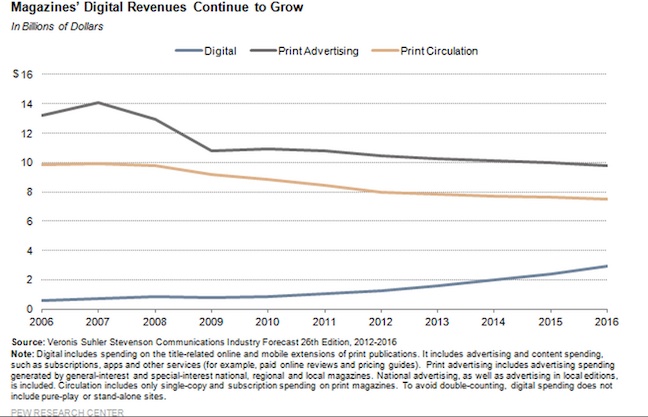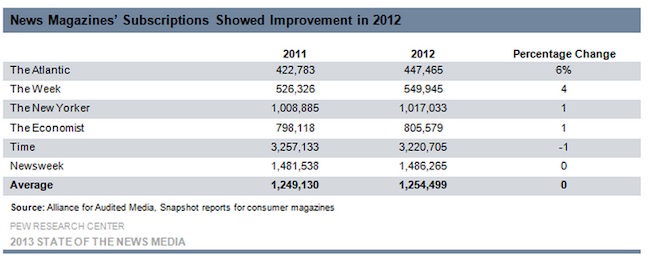Newsweek‘s announcement that it is resurrecting its print edition is probably the most dramatic sign yet that digital-only ad models predicated on free content were a disastrously wrong turn for legacy news organizations.
Indeed, for these legacy organizations, it’s the free-content idea—even more than print—that’s really gasping for breath. But this has been apparent for a while as paywalls rise around the world. Guardian!—come in, please.
The emphasis must be on the qualifier: legacy news organizations with large staffs and big fixed costs. News startups are another issue.
Jim Impoco, Newsweek‘s new editor in chief, told Christine Haughney that the new Newsweek would rely more heavily on readers than advertisers for revenue and that subscription prices would rise. He says the magazine hopes to get its circulation up to 100,000 in the first year—obviously a huge drop-off from the old Newsweek, as we’ll see below.
“It’s going to be a more subscription-based model, closer to what The Economist is compared to what Time magazine is,” Mr. Impoco said. “We see it as a premium product, a boutique product.”
And, in a note to me this morning, Impoco says this will be a push for quality subscriptions, as oppose to the giveaways and super-heavy discounts that have traditionally bloated sales figures of mass-circulation titles:
The [old] figure included a lot of giveaways and near giveaways and a lot of churn in order to keep that rate base promised to advertisers. We estimate that there were about half a million core readers—the ones who renew their subs over and over. We’re going after that 500,000—and that’s where the initial goal of 100,000 comes from. The math is simple. It costs a certain amount to produce and distribute a print product. Traditionally, magazines sold it for less than that cost and counted on advertisers to make up the different (and profits). We won’t do that.
The new model is also reminiscent of the The Economist‘s sister publication, the Financial Times, which has always had a stiff paywall, and has managed to achieve the twin milestones of gaining more revenue from readers than advertisers and more from digital than print. Print is still important but digital gains are making up for print declines. And subscriptions are expensive.
So there are two issues here: One is print. The other is free.
Print is where the legacy news organizations still get the bulk of their revenue.
Here’s the big chart for magazines, courtesy of Pew. The headline talks about digital growth, but the important thing here is the base: low for digital and still high for print:

True, print ads and circulation are both trending down, but clearly there’s money still on the table on that side of the business, as the Newsweek move recognizes.
What’s more, magazine circulation has been holding its own lately, despite terrible numbers for single-copy sales at the newsstand, and (ADDING: and subscriptions) even ticked up in 2012. Newsweek‘s own figures were flat before IAC/InterActiveCorp, announced in October of that year that they were shuttering Newsweek’s print side to save $40 million a year.

True, there was a lot of chum in that figure, as Impoco says, but the trend was flat, not down. Impoco also says the new owners are negotiating new printing and distribution contracts.
The Newsweek announcement is significant because it’s a complete reversal of a previously implemented policy, albeit under a different regime. It echoes an even-more telling about-face/train wreck in New Orleans. There, Advance Publications, after basically trashing the print model and cutting publication to three days a week, reversed itself under pressure from new competition from a rival, The Advocate, and brought out a tabloid on the days it had stopped publishing. Brilliant. But not.
Both Newsweek‘s and Advance’s abandonment of print were decisions made based on what are now clearly outdated assumptions about the robustness of the digital ad market and fuzzy ideas about the value—again, for legacy news organizations—of buzz and engagement online. This view had its heyday for a while, but now the legacy organizations have moved on and are charting a more pragmatic course. And that’s all to the good.
Dean Starkman Dean Starkman runs The Audit, CJR’s business section, and is the author of The Watchdog That Didn’t Bark: The Financial Crisis and the Disappearance of Investigative Journalism (Columbia University Press, January 2014). Follow Dean on Twitter: @deanstarkman.
